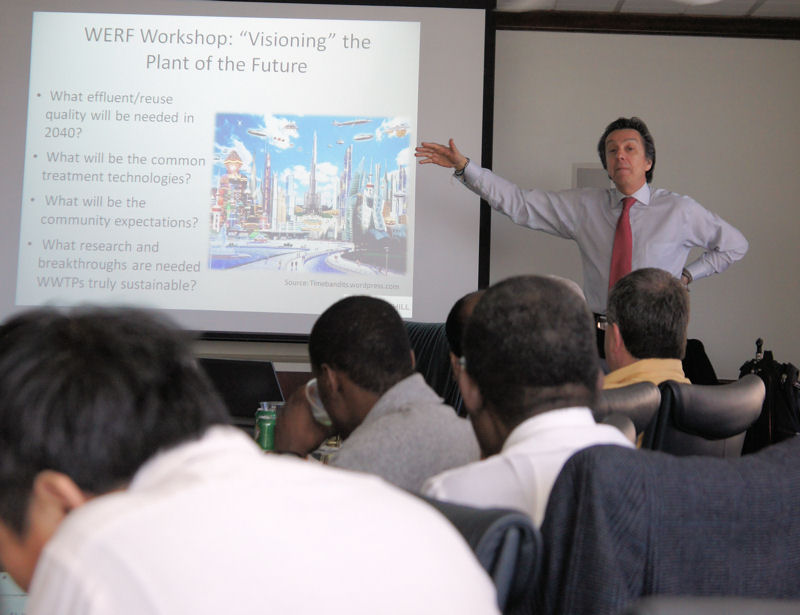
Water sector professionals gathered at Water Environment Federation (WEF; Alexandria, Va.) headquarters to hear Julian Sandino, a vice president at CH2M Hill (Englewood, Colo.) present his vision for the future. WEF photo/Jennifer Fulcher.
The future requires that wastewater treatment processes move into uncharted waters. Julian Sandino, a vice president at CH2M Hill (Englewood, Colo.), presented his vision of the sector’s future during a luncheon at the Water Environment Federation (WEF; Alexandria, Va.) headquarters on Feb. 28. The U.S. chapter of the Inter-American Association of Sanitary & Environmental Engineering (USAIDIS; Arlington, Va.) hosted the event.
Wastewater treatment evolves through the years
“This thing of water, and, in particular, wastewater management, has been evolving and will continue to evolve,” Sandino said during the luncheon. The sector is experiencing a changing paradigm that will require a new response from water resource recovery facilities, he added.
Society first dealt with wastewater as a human-health concern, transporting and discharging it as a way to avoid disease, Sandino said. Handling wastewater with a focus on controlling pollution in waterways began around 1928, he said. And now the focus is shifting again; handling wastewater is focusing on gaining a product at the end of the pipe. The sector is moving toward water reuse and reclaiming resources, he explained.
Regulations drive the business of wastewater, and likely will become stricter in the future. But it also is likely that local communities will become another driver for the sector as people become more educated and involved.
“They’re going to be dictating to us what they want, and we’d better be listening,” Sandino said.

Sandino explained that the sector is moving into a resource recovery paradigm. WEF photo/Jennifer Fulcher.
With limited resources and population growth, water will become more precious and direct potable reuse will be needed. And both communities and regulators will require water to be extremely clean, and will be willing to pay for the product. In addition, treatment processes need to be more efficient and other resources in wastewater need to be recovered, Sandino said.
“Wastewater management will have to be carbon neutral and energy self-sufficient, and likely, energy producing,” Sandino said. “We will become a net-product producing, net-benefit to society by recovering a whole bunch of resources that are embedded in wastewater,” he said.
Technological advances will enable facilities to know more about water, and facilities will become more complex. And with limited human resources, facilities will become highly automated, Sandino said. “That’s going to be a challenge for us, to find the people that are going to be able to run, and want to run [facilities],” he said.
Efforts to reclaim resources from wastewater
Resources that can be reclaimed from wastewater include liquid, nutrients, carbon, energy, and heat. As fresh, clean water becomes even more precious in the future, utilities will have to reclaim water. And water resource recovery facilities will have to extract energy embedded in biosolids or find other energy production methods such as generating hydropower or capturing thermal energy, Sandino said.
When handling biosolids, larger facilities will rely on cogeneration systems using anaerobic digestion to generate biogas. Facilities also most likely will use thermal hydrolysis to pretreat biosolids. Another trend will be adding fats, oils, and grease from such sources as restaurants directly into digesters. Cogeneration enables facilities to both remove a problematic waste for restaurants and produce more biogas, Sandino said.
Nutrient recovery also will be important because phosphorus is a finite resource. Because phosphorus often appears in the form of struvite, which causes costly problems by blocking pipes and harming systems, Sandino sees a future where the sector discovers a way to intentionally precipitate struvite somewhere in the system where it can be controlled and extracted for beneficial use.
“It’s a two-fold benefit, by managing struvite and getting it out of the system as a product, you’re reducing your discharge and/or your treatment requirements for phosphorus,” Sandino said.
“We have, as an industry, a mission to get this concept out there,” Sandino said. “We are not into the pollution elimination business; we are in the pollution conversion business.”
Educating the public and selling the product

Water resource recovery facilities will have to produce such products as energy, nutrients, and clean water in the future and then sell these products, Sandino explained at the luncheon. WEF photo/Jennifer Fulcher.
Because many future water resource recovery facilities will be product producers, they will need to educate the public about treatment processes.
“We need to get people involved,” Sandino said.
Facilities also must employ marketing and sales teams to distribute the product.
“We’re going to produce a product, how are we going to now get the product out?” Sandino asked. “We need to have people who know how to sell things.”
The sector works in the resource recovery business already, but in the future these actions will become more intensive and deliberate. This movement into new ventures will be inevitable because it is the only way to survive, Sandino said.
“Adopting a paradigm of resource recovery is not a technical challenge, it’s primarily a decision that we need to make,” Sandino said. “We don’t need to wait for the future. The future is now and we’d better start at it. And then as time develops, we’ll get better at it.”
— Jennifer Fulcher, WEF Highlights








April 29, 2014
Featured